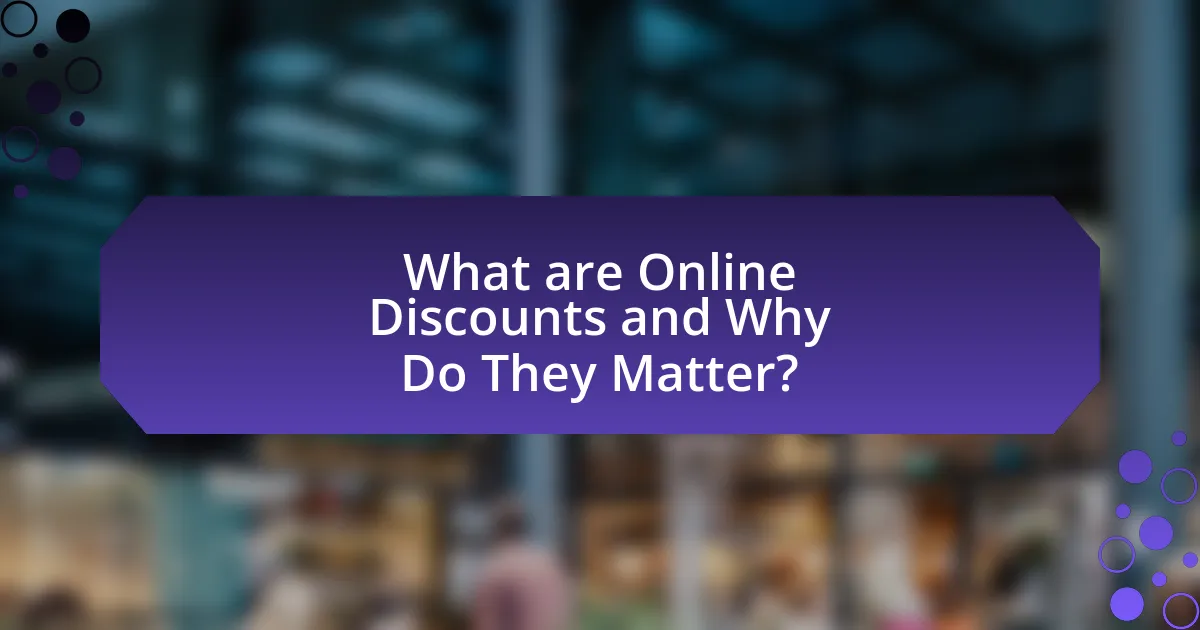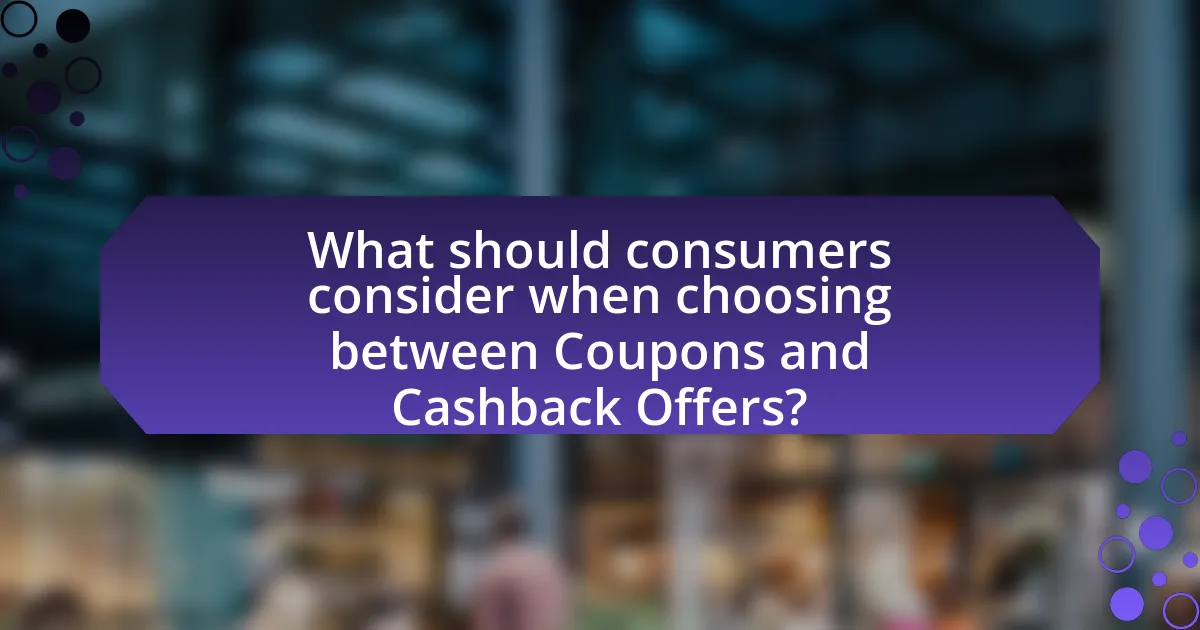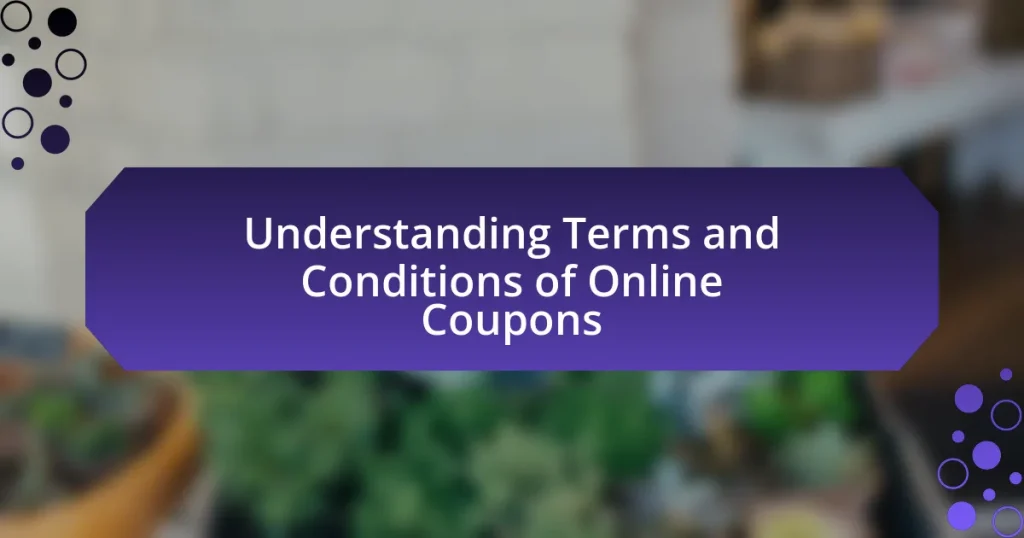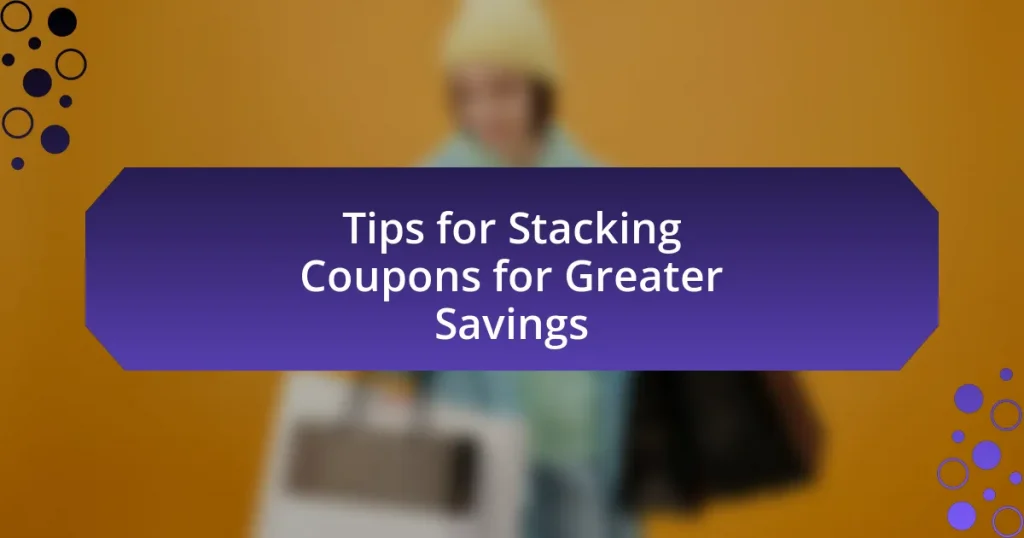Online discounts, specifically coupons and cashback offers, play a crucial role in influencing consumer purchasing behavior and enhancing retailer sales. Coupons provide immediate price reductions at checkout, while cashback offers return a percentage of the purchase amount after the transaction. This article compares the two discount strategies, detailing their key features, advantages, and psychological factors that affect their effectiveness. It also explores how consumers can maximize savings by strategically combining both methods, while highlighting common pitfalls to avoid when utilizing these offers.

What are Online Discounts and Why Do They Matter?
Online discounts are price reductions offered by retailers on products or services available through digital platforms. These discounts matter because they incentivize consumer purchases, enhance customer loyalty, and drive sales volume, ultimately benefiting both consumers and businesses. According to a 2021 study by RetailMeNot, 80% of consumers reported using online coupons, demonstrating their significant impact on shopping behavior and decision-making.
How do Coupons and Cashback Offers differ in online shopping?
Coupons provide a direct discount on the purchase price at the time of checkout, while cashback offers return a percentage of the purchase amount after the transaction is completed. Coupons typically require the user to enter a code or click a link to apply the discount immediately, resulting in a reduced total at checkout. In contrast, cashback offers are often processed through third-party platforms, where users receive the cashback amount later, usually credited to their account or sent via payment methods like PayPal. This distinction highlights that coupons offer instant savings, whereas cashback provides a delayed financial benefit, making them different strategies for consumers seeking to save money while shopping online.
What are the key features of Coupons?
Coupons are promotional tools that provide discounts or special offers to consumers when purchasing products or services. Key features of coupons include a specified discount amount or percentage, an expiration date that limits their validity, and specific terms and conditions that may restrict their use to certain products or stores. Additionally, coupons can be distributed in various formats, such as printed paper, digital codes, or mobile app offers, enhancing accessibility for consumers. According to a study by the National Retail Federation, 92% of consumers reported using coupons in 2020, highlighting their effectiveness in driving sales and customer engagement.
What are the key features of Cashback Offers?
Cashback offers provide consumers with a percentage of their purchase amount returned to them, typically as cash or credit. Key features include a defined cashback rate, which varies by retailer and product category, and eligibility criteria that specify which purchases qualify for cashback. Additionally, cashback offers often have expiration dates, requiring consumers to act within a certain timeframe to benefit. Many cashback programs also require users to register or sign up, and they may involve tracking purchases through specific platforms or apps. According to a 2021 study by Statista, 52% of consumers reported using cashback offers as a primary incentive for online shopping, highlighting their effectiveness in driving sales.
What are the advantages of using Coupons?
Coupons provide significant advantages, including immediate savings, increased customer loyalty, and the ability to attract new customers. Immediate savings occur when consumers apply coupons at checkout, resulting in reduced prices for products or services. Research indicates that 92% of consumers use coupons, demonstrating their effectiveness in driving purchases. Additionally, businesses that offer coupons often see enhanced customer loyalty, as shoppers are more likely to return for future discounts. This loyalty can lead to repeat business, which is crucial for long-term profitability. Furthermore, coupons can attract new customers who may be incentivized to try a brand or product they haven’t purchased before, expanding the customer base.
How do Coupons enhance customer loyalty?
Coupons enhance customer loyalty by providing tangible savings that incentivize repeat purchases. When customers receive discounts through coupons, they perceive added value in their shopping experience, which fosters a sense of appreciation and encourages them to return. Research indicates that 68% of consumers are more likely to shop at a store again if they receive a coupon, demonstrating the direct correlation between coupon usage and customer retention. Additionally, coupons can create a habit of shopping at specific retailers, as customers often seek out those brands that offer regular discounts, further solidifying their loyalty.
What types of products are most commonly discounted with Coupons?
Products most commonly discounted with coupons include groceries, personal care items, household supplies, and apparel. Research indicates that grocery items account for a significant portion of coupon usage, with 92% of consumers using coupons for food products, according to a study by the Food Marketing Institute. Additionally, personal care products and household supplies frequently feature coupons, as brands aim to attract consumers to their products through discounts. Apparel also sees substantial coupon discounts, particularly during seasonal sales and promotional events.
What are the advantages of using Cashback Offers?
Cashback offers provide consumers with a direct financial incentive by returning a percentage of their purchase amount, effectively reducing the overall cost of goods or services. This mechanism encourages spending while rewarding customers for their loyalty, as many cashback programs are tied to specific retailers or credit cards. According to a 2021 study by the National Retail Federation, 79% of consumers reported that cashback offers influence their purchasing decisions, highlighting their effectiveness in driving sales. Additionally, cashback offers can be combined with other promotions, maximizing savings for consumers and enhancing their shopping experience.
How do Cashback Offers incentivize repeat purchases?
Cashback offers incentivize repeat purchases by providing consumers with a financial reward for their spending, which encourages them to return for future transactions. When customers receive a percentage of their purchase back, it creates a sense of value and satisfaction, making them more likely to shop again. Research indicates that 79% of consumers are more likely to make a repeat purchase if they receive cashback, as it enhances their overall shopping experience and fosters brand loyalty. This financial incentive effectively transforms one-time buyers into repeat customers, as they associate the brand with positive rewards and savings.
What platforms typically offer Cashback Deals?
Platforms that typically offer Cashback Deals include Rakuten, Honey, and TopCashback. These platforms partner with retailers to provide users with a percentage of their purchase amount back as cash. For instance, Rakuten has reported over $1 billion in cash back paid to its users since its inception, demonstrating its effectiveness in facilitating cashback offers.

How do Coupons and Cashback Offers impact consumer behavior?
Coupons and cashback offers significantly influence consumer behavior by incentivizing purchases and increasing overall spending. Research indicates that 92% of consumers use coupons, and 60% of shoppers are more likely to buy a product when a cashback offer is available. These incentives create a sense of urgency and encourage consumers to make purchases they might otherwise postpone. Additionally, cashback offers often lead to higher average order values, as consumers tend to add more items to their carts to maximize savings. This behavior is supported by a study from the Journal of Marketing Research, which found that promotional offers can enhance perceived value and drive repeat purchases.
What psychological factors influence the effectiveness of Coupons?
The effectiveness of coupons is influenced by several psychological factors, including perceived value, scarcity, and social proof. Perceived value refers to the consumer’s belief that they are receiving a significant discount, which can enhance their motivation to purchase. Scarcity, such as limited-time offers, creates urgency and can lead to impulsive buying behavior. Social proof, where consumers observe others using coupons or sharing their savings, can also enhance the perceived desirability of using coupons. Research indicates that these psychological triggers can significantly increase coupon redemption rates, as consumers are more likely to act when they feel they are getting a good deal, face time constraints, or see others benefiting from the offer.
How do perceived savings affect purchasing decisions?
Perceived savings significantly influence purchasing decisions by enhancing the attractiveness of a product or service. When consumers believe they are saving money, they are more likely to make a purchase, as this perception creates a sense of value and urgency. Research indicates that 70% of consumers are motivated to buy when they perceive a discount, demonstrating the strong correlation between perceived savings and purchasing behavior. This effect is particularly pronounced in online shopping environments, where coupons and cashback offers can amplify the perception of savings, leading to increased conversion rates.
What role does urgency play in Coupon usage?
Urgency significantly influences coupon usage by creating a time-sensitive motivation for consumers to make purchases. When coupons have expiration dates or limited availability, they prompt immediate action, leading to increased conversion rates. Research indicates that urgency can enhance consumer decision-making, as seen in a study by Cialdini et al. (2006), which found that scarcity and time constraints can drive higher sales. This psychological trigger encourages shoppers to prioritize coupon redemption, ultimately boosting retailer sales and customer engagement.
What psychological factors influence the effectiveness of Cashback Offers?
Cashback offers are influenced by several psychological factors, including perceived value, loss aversion, and instant gratification. Perceived value plays a crucial role as consumers often evaluate cashback as a reward, enhancing their overall shopping experience. Research indicates that when consumers believe they are receiving a financial benefit, their likelihood of making a purchase increases significantly. Loss aversion, a concept from behavioral economics, suggests that consumers are more motivated to avoid losses than to acquire equivalent gains; thus, the idea of receiving money back can be more appealing than a simple discount. Additionally, the desire for instant gratification drives consumers to prefer immediate rewards, making cashback offers attractive as they provide a tangible benefit post-purchase. These psychological factors collectively enhance the effectiveness of cashback offers in driving consumer behavior and increasing sales.
How does the delayed reward of Cashback affect consumer satisfaction?
The delayed reward of Cashback negatively affects consumer satisfaction due to the anticipation gap between the purchase and the reward receipt. Consumers often experience frustration when they must wait for the Cashback to be credited, which can diminish the immediate gratification associated with a purchase. Research indicates that immediate rewards enhance satisfaction more effectively than delayed ones; for instance, a study published in the Journal of Consumer Research found that consumers prefer instant rewards over delayed ones, as the latter can lead to feelings of uncertainty and dissatisfaction. Thus, while Cashback offers can be appealing, the delay in receiving the reward can ultimately reduce overall consumer satisfaction.
What are the common misconceptions about Cashback Offers?
Common misconceptions about cashback offers include the belief that they are free money, that they apply to all purchases, and that they are always the best option for savings. Cashback offers are not free money; they require an upfront purchase, and the cashback is a percentage of the amount spent, not an additional bonus. Additionally, cashback offers often exclude certain categories or products, meaning they do not apply universally to all purchases. Lastly, while cashback can provide savings, it may not always be the most advantageous option compared to other discounts like coupons, which can sometimes offer greater immediate savings on specific items.

What should consumers consider when choosing between Coupons and Cashback Offers?
Consumers should consider the total savings potential and ease of use when choosing between coupons and cashback offers. Coupons typically provide a fixed discount on the purchase price, while cashback offers return a percentage of the purchase amount after the transaction is completed. For example, a coupon for $10 off a $50 purchase results in a 20% discount, whereas a 10% cashback offer on the same purchase yields $5 back. Additionally, consumers should evaluate the terms and conditions associated with each option, as cashback offers may require a minimum spend or specific payment methods, while coupons may have expiration dates or restrictions on eligible products. Understanding these factors helps consumers maximize their savings effectively.
How can consumers evaluate the best option for their shopping needs?
Consumers can evaluate the best option for their shopping needs by comparing the total savings from coupons and cashback offers. To do this effectively, consumers should calculate the final price after applying coupons and compare it to the price after receiving cashback on purchases. Research indicates that coupons can provide immediate discounts, while cashback offers may yield higher savings over time, depending on the purchase amount and frequency of use. For instance, a study by the National Retail Federation found that 92% of consumers use coupons, highlighting their popularity and potential for savings. By analyzing both options, consumers can determine which method maximizes their savings based on their shopping habits and preferences.
What factors should be considered when assessing the value of a Coupon?
When assessing the value of a coupon, key factors include the discount percentage, expiration date, usability restrictions, and the minimum purchase requirement. The discount percentage directly affects the savings a consumer can achieve; for example, a 20% off coupon on a $100 purchase saves $20. The expiration date is crucial as it determines how long the coupon remains valid, influencing its immediate value. Usability restrictions, such as specific product applicability or store limitations, can also impact the coupon’s effectiveness; a coupon valid only for select items may not provide value if those items are not needed. Lastly, a minimum purchase requirement can affect the overall savings; for instance, a coupon that requires a $50 minimum purchase may not be beneficial for someone only intending to buy a $30 item. These factors collectively determine the overall value of a coupon in a shopping context.
What factors should be considered when assessing the value of a Cashback Offer?
When assessing the value of a Cashback Offer, key factors include the percentage of cashback, the minimum purchase requirement, the duration of the offer, and any restrictions on eligible products. The percentage of cashback directly impacts the financial benefit; for instance, a 5% cashback on a $100 purchase yields $5, while a 1% cashback yields only $1. Minimum purchase requirements can limit the offer’s applicability; if a $50 minimum is set, a consumer must spend at least that amount to benefit. The duration of the offer is crucial as well; limited-time offers may create urgency but could also lead to hasty purchases. Lastly, restrictions on eligible products can significantly affect the overall value; if the cashback applies only to select items, the consumer’s choices may be limited, reducing the offer’s attractiveness.
What are some tips for maximizing savings with Coupons and Cashback Offers?
To maximize savings with coupons and cashback offers, consumers should strategically combine both methods. Using coupons at checkout reduces the initial purchase price, while cashback offers provide a percentage of the total spent back to the consumer, effectively lowering the overall cost. Research indicates that consumers can save an average of 20% when combining these strategies, as reported by the National Retail Federation. Additionally, signing up for cashback websites and apps can provide exclusive offers and higher cashback rates, further enhancing savings potential. Regularly checking for new coupons and cashback deals before making purchases ensures that consumers take full advantage of available discounts.
How can consumers effectively combine Coupons and Cashback Offers?
Consumers can effectively combine coupons and cashback offers by first applying the coupon at checkout to reduce the initial purchase price, then ensuring that the transaction qualifies for cashback from the retailer or cashback app. This method maximizes savings, as the coupon lowers the total amount spent, and the cashback is calculated based on the final price after the coupon is applied. For instance, if a consumer uses a $10 coupon on a $50 purchase, they pay $40, and if the cashback offer is 5%, they receive $2 back, resulting in a total savings of $12. This strategy is validated by various retailers that allow stacking discounts, enhancing the overall value for consumers.
What are the common pitfalls to avoid when using Coupons and Cashback Offers?
Common pitfalls to avoid when using coupons and cashback offers include overlooking expiration dates, failing to read the terms and conditions, and not comparing prices. Expiration dates can render a coupon useless, leading to missed savings. Terms and conditions often contain restrictions that limit the applicability of the offer, such as minimum purchase amounts or specific product exclusions. Additionally, prices may be inflated before applying discounts, making it essential to compare the final price after the coupon or cashback is applied to ensure genuine savings.



